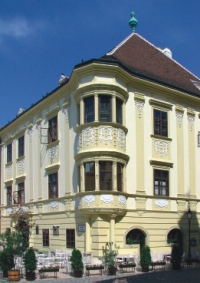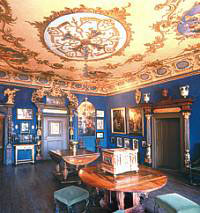Storno House, Storno Collection
Sopron, Fő tér 8.
 |
The castle-like Baroque corner house is one of the most attractive sights of the Main Square. In the 15th century it was the property of the Haberleiter family, and provided accommodation for King Matthias in 1482–83, when he assaulted the town of Vienna. The building became the property of the Festetics family in the 18th century, when it got its final shape. The Storno family purchased the building in 1872. It was the venue of two concerts played by Franz Liszt, in 1840 and 1881. The most eye-catching characteristics of the building are the closed, round, two-storey corner balcony with its rich ornamentation, the basket-arched gate with the Festetics family’s coat of arms between the two Tuscan half pillars, and the door knockers with their pelican motifs. Sopron’s first apothecary, the Black Elephant (Fekete Elefánt) was operating in this building in the 15th century.
The Storno family originates from Tessin Province in Switzerland. Ferenc Storno the elder was born in Kismarton (Eisenstadt) in 1821, and grew up in Landshut. His drawing talent was revealed very early, but this poor family of chimney-sweeps could not afford to finance his education. He was forced to continue his father’s profession but he spent all his leisure time drawing. He settled in Sopron in 1845, and soon after he found a job with a master chimney-sweep. After the master’s death, he married the widow to carry on the business. He soon became the most popular picture restorer of the Monarchy, thanks to his mentors, who recognized and appreciated his talent. He had the opportunity to work in Vienna for a few months in 1850. He dealt with the valuation of monuments and the design of objects for Prince Leopold Habsburg. He started working in Hungarian monument research in 1860.
 |
He took part in the restoration of the St. Mihály Church in Sopron and the reconstruction of the crypt and the church in Pannonhalma Abbey. From the 1870s onwards, he worked with his sons, Ferenc and Kálmán. In accordance with the family traditions, the boys were chimney-sweeps by profession, but also studied art at foreign academies. Ferenc Storno was the saviour of a lot of art treasures, which served as the basis for the famous Storno Collection. The rooms, decorated with antique furniture as well as the works of family members, give a true picture of interior design at the end of the 19th century. The collection comprises valuable items of furniture, weaponry, china and glass art, which can be seen on the second floor, where the family lived from 1875 to 1984.